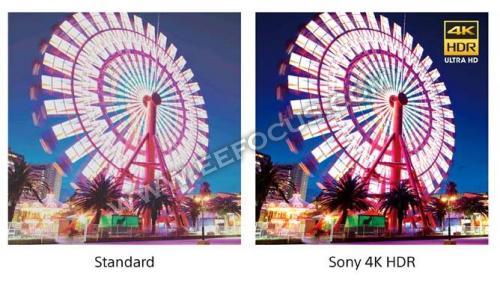At the CES 2018, it is expected that more 4K TVs with HDR technology and integrated digital voice assistance will be seen.
At the dawn of the new year, there are some major trends in the television industry. In 2018, consumers who purchase TVs are expected to see more super-sized TVs that have enhanced display capabilities and sophisticated voice control capabilities.
These may lead to a series of changes, but compared to 2017, there has been no significant technical change.
How big is the oversize? We expect to see more 65- to 75-inch models on the 2018 at CES (the annual big consumer electronics show in Las Vegas). Moreover, due to price cuts, more consumers can afford such large-size TV sets.
As for display performance, quantum dots and new backlight technologies are pushing LCDs closer to OLED TVs.
In addition to scale and performance, 2018 will be the year of voice digital assistants. Alexa, from the speaker to the TV, has brought a new level of voice control and interaction with other smart products. This means that we may see more TVs that will integrate into voice assistants (like Amazon Alexaand, Google Assistant) as part of their smart DNA.

Therefore, although we do not expect that any unexpected development in 2018 will completely change consumer choice. But for television consumers, these new developments will make 2018 an interesting year in the history of television sets.
The following is the 2018 TV trend.
1. The TV screen becomes bigger
Remember how big a 42-inch TV looked in the year, and today's 55-inch and even 65-inch TVs are commonplace. Industry experts predict that these large-screen TVs will account for a larger share of TV sales in 2018, especially if the prices of large-size TVs continue to fall.
The market research company IHS Markit predicts: "In 2018, the market share of televisions in North America with 65-inch and above will increase by 37%."
Gap Intelligence, a retail market research firm, also agreed that it was the first time that 65-inch-and-larger TV retail volumes had been flat with 55-inch and 60-inch TVs.
The company explained: "This growth is largely driven by the rise of 4K TV. The 4K TVs are mainly 55-inch and 65-inch. In this large size, the benefits of high resolution can be better. In the past few years, as more and more brands have entered the 4K market, the total retail volume of major retailers of 65-inch and larger TV sets has increased by 33%."
Kennedy pointed out that several major TV brands such as Samsung, Sony, LG and Vizio have already set up stores in major electronics stores such as Best Buy. These branded monitors usually use a larger screen size to deepen consumers' impressions of the product.
Research company NPD Group stated: "The reason why consumers want bigger screens is because the largest and best screen in the house is for public viewing. The family is watching sports, movies or Netflix together." Baker pointed out that as more and more people watch videos on other devices such as tablets and smart phones, the screen size is getting smaller and smaller.
“People are willing to spend their money on televisions with large screens, put televisions in the living room, and then use other devices to watch video outside the living room.â€
IHS said that if you want to buy a real big TV, you may have to wait a year. Because the new plant (manufacturing facility for manufacturing large LCD panels) will not be on the line until a while.
"These new LCD display factories are optimized for 65-inch and 75-inch TVs. One of them will be put into operation in February next year, and the other three will be put into production in 2019," IHS said. This means that in the future it will be possible to efficiently cut larger LCD panels from large liquid crystal displays (so-called mother glass). These new factories can produce more mother glass panels, so reducing waste and helping to reduce costs, and TV prices are reduced.
2. Let More Television Have Better HDR
Another TV trend last year, High Dynamic Range (HDR), has once again become one of the hottest TV topics this year, both for consumers and for television sales.
A headache for consumers is that although many 4K TVs claim to have HDR capabilities, most consumers do not know what kind of experience will be HDR until they buy the TV home.
This is because many cheaper TV sets do not have enough brightness, black level, and video processing capabilities to truly show the full effect of the HDR program. This is why television ratings now provide a description of HDR effectiveness in detailed test results.

Last year, only expensive TVs provided an effective HDR experience. But this year, the head of the consumer report TV test said, "We hope that more 4K TVs will be able to expand the brightness range and enhance the handling of subtle shadow details in order to achieve good HDR requirements."
He also stated that he hopes that manufacturers can better optimize TV default image settings when playing HDR content so that consumers do not have to make adjustments by themselves.
3. Voice interaction leap forward
At present, major brands of television have a certain degree of voice interaction. It is usually through talking to the microphone built into the remote control that you can change the channel, adjust the volume, and even use voice commands to search for content. But this year, experts in the television industry said that some companies will integrate digital voice assistants (such as Amazon Alexa and Google Assistant) into their own smart TV platforms to make the voice interaction of the TV even better.
In 2017, TVs such as the Element and Westinghouse brands used the Amazon Fire TV system (including Alexa) as their smart TV platform. Recently Android TV is also using Google Assistant as its smart TV platform.
In 2018, even if only a few brands will use Alexa (if not the entire Amazon Fire TV platform) or Google Assistant, but we also have reason to expect the smart TV system will be more widely used in the future.
These TVs can not only use these voice assistants to search and access content, but also interact and control with other compatible smart home devices such as lighting, thermostats, and speakers.
4. New TV Technology Gets Showcase
Perhaps the most interesting TV technology we can hear at the CES 2018 is the "self-illuminating" LED, which makes the LCD screen more like an OLED screen. Some companies, including Samsung and Sony, have been working hard to develop this technology, in which the LED can self-illuminate, eliminating the need for backlighting.
According to IHS analysts, this may refer to what the industry calls "miniature light-emitting diodes." Although this technology has many advantages, it also has a very significant disadvantage that it is very expensive. At present, we only see the use of micro LEDs for commercial applications, and perhaps it will also penetrate consumer TVs, but it may take several years.
He also said: "This year's major impact is the improvement of LCD TV backlighting technology. Since LCD TV backlights are always on, TVs try to block light in dark scenes, but some light is always coming in. This may be Makes the black look grey or halo around a light image on a dark background."
Full array of LED backlights, LEDs are arranged across the panel, not just at the edges. This is a way to improve the performance of LCD TVs.
"I look forward to seeing more full-area local dimming LED backlights to improve LCD performance relative to OLEDs," the analyst explained. “Last year, Samsung has gradually disappeared from the full array of local dimming in pursuit of a thinner profile, but I think it is unfavorable to them. Last year, the Z9 series uses full-array backlight and local dimming, Sony has therefore proved The performance of LCDs can be comparable to OLEDs in many cases."
5. 8K and new version of HDMI
Although 4K TV is becoming mainstream, there may be discussions and demonstrations on 8K monitors or higher resolution TVs at CES.
Most industry observers believe that 8K TV is still a few years away from the actual consumer choice. Although Japan is already conducting an 8K television broadcasting experiment, some of the high-profile events such as the upcoming Olympic Games will also be shot at 8K. However, it should be noted that broadcasters are still struggling to deal with the amount of bandwidth required for 4K transmission.
We also hope that the TV will have a faster frame rate, but it will not have any effect on the 2018 TV. Sports Internet TV is particularly interested in this technology, which doubles the number of frames per second displayed on a television (this refers to content captured at 120 frames per second instead of the current 60 frames per second). Helps reduce motion blur in fast-moving scenes.
To handle these needs more bandwidth and a new version of HDMI. HDMI 2.1 has just completed, it supports up to 10K video resolution, 120Hz frame rate. There will also be new, ultra-fast HDMI cables.
We do not think HDMI 2.1 will have a big impact in 18 years. IHS analysts believe that 8K TV needs HDMI 2.1 more than 4K TV.
NPD analysts even more bluntly: "Nobody cares about HDMI 2.1, nor should it be. It's not a reason to buy a TV. But by 2020, all TVs will have it."
6. China's brand growth momentum is strong
The sales volume and influence of China's TV manufacturers have continued to increase globally for several years. According to IHS Markit data, Hisense and TCL are among the top ten LCD TV brands in the world.
Among them, Hisense, which holds shares in the United States’ Sharp TV brand, uses quantum dots in its flagship “ULED†TV from a technical point of view, and is more aggressive.
But TCL, a Roku TV early adopter and strong supporter, was more successful in sales, which is why more Roku TVs can be seen in the store or in life.
"Over the past year, both companies have performed more positively in the U.S. market," said a Gap spokesman. “In 2017, TCL significantly increased its business at major national retailers, largely because it entered Best Buy for the first time and placed it at Target and Walmart. Double the number of stores."
She added that although Hisense’s retail sales in the past two years have also increased significantly, it is still less than TCL.
The CR ratings of both companies tend to be midpoint scores. However, we have seen that in the past two years, the rating of each brand has increased.
"TCL has added the popular Roku smart TV operating system to its TV and expanded its 4K category, with several levels to choose from," she said. "Hisense is behind TCL in terms of retail stores and TV features, but its brand and marketing plans are doing well, and its low prices have also attracted many consumers."
25*50mm Low Profile White Faceplate
included or excluded keystones for Keystones, or designed with PC board
fixtures and fittings provided
for Solid Cat 5 or Cat 6 cable
size is 25*50mm basing on UK type standard
Material as ABS, PC, PBT in UL94V-0 standards
Operation temperture -40~70 ℃
Could accept any combination of UONICRE Keystone Jack or RJ45 connectors
UK Face Plate,Outlet Face Plate,Wall Socket Face Plate,Face Plate Wall Socket
NINGBO UONICORE ELECTRONICS CO., LTD , https://www.uniconmelectronics.com
![<?echo $_SERVER['SERVER_NAME'];?>](/template/twentyseventeen/skin/images/header.jpg)